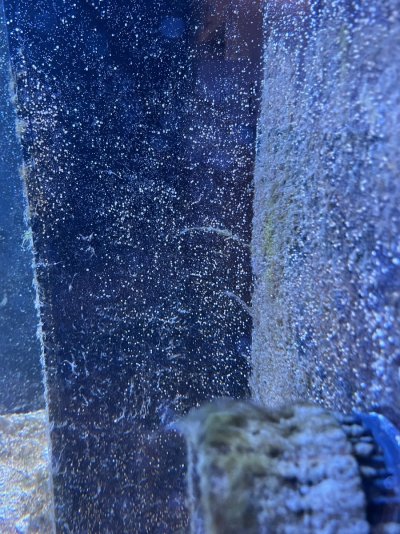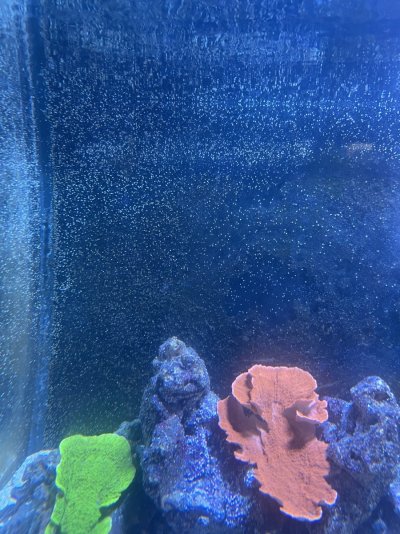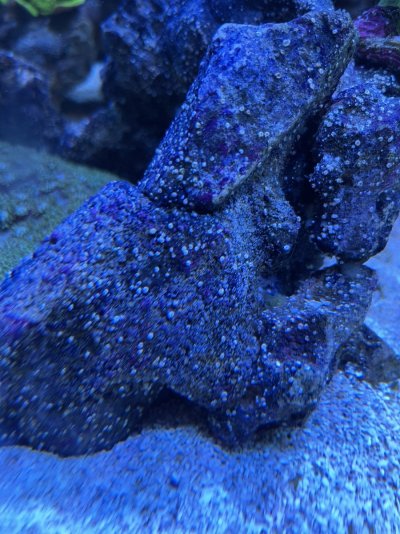Let me preface this by saying I know a lot of reefers like this worm. They're considered a nutrient exporter, and a sign of a mature tank. But I personally hate them, they're unsightly and explode in population to the point where they cover not just my glass, filters and other equipment, but also all of my liverock, and on the shells of my hermits!!
I want them gone, eliminated, genocided, death to them. And I'll dedicate this thread to their extinction from my tank, and hope we can all finally find a permanent solution to them. So please let's just discuss elimination methods, not about whether they're good or not for the reef system.
First, physical removal with manual force.
- Scrape off glass using blade or whatever blunt scrapper: While this will work, it only works on straight surfaces like the aquarium glass. Try scrapping these worms off your rockwork, that has incongruent angles and shapes. It's gonna take a year+ to scrape it all off.
- Reduce feeding: already done. Even have other nutrient exporters like gracilaria algae and ulva to keep water in check. Might have reduced the rate of Spirorbid growth a little bit, but now I can't provide feasts to my fish for fear of overfeeding the worms, and now my algae is rate-limited in their growth due to underfeeding of the fish.
No one wants to spend time going through rockwork and other weird angles to get rid of them. Physical scrapping only gets them off the hard surface, and does not eliminate future broods from establishing themselves on the rockwork again. The second solution doesn't get rid of the worms completely, only reduces their growth rate by a little bit. But it comes with the cost of my happiness of seeing my fish eat hearty, and at the expense of the bushes of algae that I want to see growing in my tank. PHYSICAL ELIMINATION is a waste of time and REDUCES the joy of having a fish tank: NO GO.
I've read of several organic solutions on the internet:
- Add bumblebee snails, peppermint shrimps, hermit crabs: No verified evidence that any of them actually prey on these worms to a significant degree. And my hermits do not eat them.
- Add Vayssierea felis (slug): While this is a natural predator of Spirorbids, these guys are impossible to find in the market. Also, they won't get rid of Spirorbids in other areas of the tank, like the separate filter areas where media is stored (and on the media themselves). Also cannot find information if these guys will eat the calcified shell the worms leave behind, because then the worms will grow and then get eaten, the calcified shells will still appear everywhere over time.
And that's it. The first solution is expensive and a crapshoot, the animals there may not even bother with the worms. The second solution with the slugs may work but doesn't eliminate Spirorbids completely, and are also rare in the market.
So organic solutions are OUT.
Next, let's dabble with chemical solutions.
- Prazi Pro: Active ingredient is Praziquantel. A dewormer that is used to kill specific type of worms: flukes, tapeworms, flatworms, and turbellarians. I do not think Spirorbid worms fall under this category, so I am not confident this will work. Has anyone used this to specifically kill Spirorbid worms?
- API General Cure: Active ingredient Praziquantel, Metronidazole. Used for treating internal parasites.
Both these solutions are used for treating specific worms, mainly internal parasites/worms. I cannot find hard evidence that the active ingredients in these two products will positively cause Spirorbid mortality. In fact, there is evidence that Spirorbid worms CAN SURVIVE in praziquantel solutions:
> praziquantel 5 100 mgS1 ) produced limited mortality to spionids in vitro 20 d post treatment (Appendix 41)
5 100 mgS1 ) produced limited mortality to spionids in vitro 20 d post treatment (Appendix 41)
Most chemical soutions for de-wormers contain praziquantel, so chemical solutions are INEFFECTIVE.
Now what's left? The only thing I can think of is to NUKE the tank with copper. Spirorbid worms are invertebrates, and all invertebrates are killed with copper. Therefore, all current and future infestations of Spirorbid worms can be eliminated using copper. Cupramine seems like the go-to for copper, and Cuprisorb is used to absorb the copper when it leaches out after being attached to liverock/sand.
This means I have to put up a separate tank to house my shrimps and crabs while I dose my infested tank with cupramine.
So, if I'm going this route, what do you think of this strategy:
- Remove shrimp and crabs from Main tank
- Freshwater dip shrimp/crabs, then put them in Temporary tank.
- Dose cupramine in Main tank for N days
- After N days, water change everyday and put in Cuprisorb for M days.
- After M days, freshwater dip shrimp/crabs from Temporary tank back to Main tank.
My main concern is that the Spirorbid worms may transfer to the Temporary tank somehow, and then when I transfer back to the Main tank, the Spirorbid worms come back with them. Especially concerning is that some of the spirorbid worms have established themselves on some of my hermit's shells, so there is already risk of re-infestation of Spirorbids.
And what would you guys say would be the N and M days parameters? 10 days of Cupramine, and 10 days of Cuprisorb, on average? I will test for copper of course, but want to know the general timeframe of how long I need to keep up this regimen of copper dosing and removal.
I really hate these worms. Any insight into working solutions to eradicate them 100% would be very helpful! Any information on copper treatments with respect to Spirorbid worms are most welcome too.
I want them gone, eliminated, genocided, death to them. And I'll dedicate this thread to their extinction from my tank, and hope we can all finally find a permanent solution to them. So please let's just discuss elimination methods, not about whether they're good or not for the reef system.
First, physical removal with manual force.
- Scrape off glass using blade or whatever blunt scrapper: While this will work, it only works on straight surfaces like the aquarium glass. Try scrapping these worms off your rockwork, that has incongruent angles and shapes. It's gonna take a year+ to scrape it all off.
- Reduce feeding: already done. Even have other nutrient exporters like gracilaria algae and ulva to keep water in check. Might have reduced the rate of Spirorbid growth a little bit, but now I can't provide feasts to my fish for fear of overfeeding the worms, and now my algae is rate-limited in their growth due to underfeeding of the fish.
No one wants to spend time going through rockwork and other weird angles to get rid of them. Physical scrapping only gets them off the hard surface, and does not eliminate future broods from establishing themselves on the rockwork again. The second solution doesn't get rid of the worms completely, only reduces their growth rate by a little bit. But it comes with the cost of my happiness of seeing my fish eat hearty, and at the expense of the bushes of algae that I want to see growing in my tank. PHYSICAL ELIMINATION is a waste of time and REDUCES the joy of having a fish tank: NO GO.
I've read of several organic solutions on the internet:
- Add bumblebee snails, peppermint shrimps, hermit crabs: No verified evidence that any of them actually prey on these worms to a significant degree. And my hermits do not eat them.
- Add Vayssierea felis (slug): While this is a natural predator of Spirorbids, these guys are impossible to find in the market. Also, they won't get rid of Spirorbids in other areas of the tank, like the separate filter areas where media is stored (and on the media themselves). Also cannot find information if these guys will eat the calcified shell the worms leave behind, because then the worms will grow and then get eaten, the calcified shells will still appear everywhere over time.
And that's it. The first solution is expensive and a crapshoot, the animals there may not even bother with the worms. The second solution with the slugs may work but doesn't eliminate Spirorbids completely, and are also rare in the market.
So organic solutions are OUT.
Next, let's dabble with chemical solutions.
- Prazi Pro: Active ingredient is Praziquantel. A dewormer that is used to kill specific type of worms: flukes, tapeworms, flatworms, and turbellarians. I do not think Spirorbid worms fall under this category, so I am not confident this will work. Has anyone used this to specifically kill Spirorbid worms?
- API General Cure: Active ingredient Praziquantel, Metronidazole. Used for treating internal parasites.
Both these solutions are used for treating specific worms, mainly internal parasites/worms. I cannot find hard evidence that the active ingredients in these two products will positively cause Spirorbid mortality. In fact, there is evidence that Spirorbid worms CAN SURVIVE in praziquantel solutions:
> praziquantel
Most chemical soutions for de-wormers contain praziquantel, so chemical solutions are INEFFECTIVE.
Now what's left? The only thing I can think of is to NUKE the tank with copper. Spirorbid worms are invertebrates, and all invertebrates are killed with copper. Therefore, all current and future infestations of Spirorbid worms can be eliminated using copper. Cupramine seems like the go-to for copper, and Cuprisorb is used to absorb the copper when it leaches out after being attached to liverock/sand.
This means I have to put up a separate tank to house my shrimps and crabs while I dose my infested tank with cupramine.
So, if I'm going this route, what do you think of this strategy:
- Remove shrimp and crabs from Main tank
- Freshwater dip shrimp/crabs, then put them in Temporary tank.
- Dose cupramine in Main tank for N days
- After N days, water change everyday and put in Cuprisorb for M days.
- After M days, freshwater dip shrimp/crabs from Temporary tank back to Main tank.
My main concern is that the Spirorbid worms may transfer to the Temporary tank somehow, and then when I transfer back to the Main tank, the Spirorbid worms come back with them. Especially concerning is that some of the spirorbid worms have established themselves on some of my hermit's shells, so there is already risk of re-infestation of Spirorbids.
And what would you guys say would be the N and M days parameters? 10 days of Cupramine, and 10 days of Cuprisorb, on average? I will test for copper of course, but want to know the general timeframe of how long I need to keep up this regimen of copper dosing and removal.
I really hate these worms. Any insight into working solutions to eradicate them 100% would be very helpful! Any information on copper treatments with respect to Spirorbid worms are most welcome too.
Last edited:

















